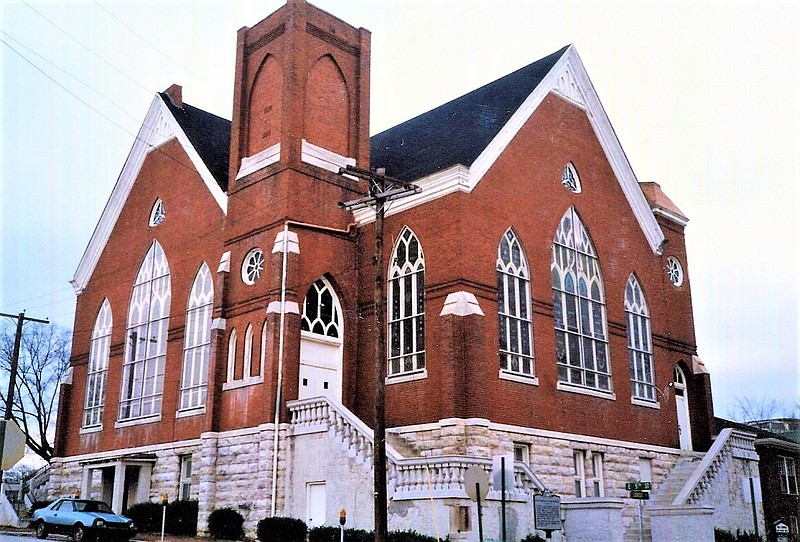If a community's history is a woven tapestry of hues, then the fabric of Chattanooga features a golden thread highlighting its historic houses of worship. With late spring's weather offering the ideal time for a walking tour of downtown Chattanooga, that trek should include two of Chattanooga's oldest houses of worship: First-Centenary United Methodist Church and Wiley Memorial United Methodist Church.
First-Centenary United Methodist Church on McCallie Avenue traces its history to two of Chattanooga's early churches, Centenary Methodist Church and First Methodist Church. Both institutions were Chattanooga landmarks for more than 100 years, ultimately merging to better provide spiritual leadership for the community.
When the Tennessee General Assembly approved the incorporation of the town of Chattanooga on Dec. 20, 1839, the town's first Methodist church had recently been organized in a log cabin located at the corner of Lookout Street and Georgia Avenue. Just over 20 years later during the Union occupation of Chattanooga, local residents who had been members of Methodist churches in their northern towns chose to organize their own church, First Methodist Episcopal Church. The members of this church, often referred to as the "Stone Church" for one of its later buildings, persuaded friends and businesses back home to also support the building of a university, enhancing the future of the community.
While the intense fighting during the U.S. Civil War left its mark on Chattanooga, so did both Methodist churches more constructively have an impact. Each increased in membership and boasted members who served the city in prominent businesses, industries and civic causes. Both mobilized their membership to assist area residents during the difficult years following the war and well into the 20th century. Church outreach programs in educational and community efforts served families and individuals.
Centenary Methodist became the first city missionary through its involvement in the organization of the Methodist Neighborhood Centers and the Asbury Center at Oak Manor. As familiar as Chattanoogans are today with Goodwill, few realize that First Methodist was instrumental in bringing Goodwill to Chattanooga or in coordinating the founding of Chattanooga's Florence Crittenton Home, a program that would serve more than 8,000 young women and their babies during its existence.
In 1911, the two local churches initiated a movement to unify the denominational branches of the Methodist church. On May 10, 1939, the Methodist Episcopal Church, the Methodist Episcopal Church South and the Methodist Protestant Church became one great church identified as "The Methodist Church." First-Centenary Methodist Church, created from the 1967 merger of the two local churches, would rise from that union.
Wiley Memorial United Methodist Church — originally known as Wiley Memorial Methodist Episcopal — stands today at 500 Lookout St., where it has been since the last days of Ross's Landing. Wiley Memorial's history is in fact a mirror for Chattanooga's history. During the critical Battles for Chattanooga, the church served as both a hospital and a prison for Confederate forces and was then used by the occupying Union soldiers as a military prison. Its military use damaged the building so badly that the site was sold for $1,000 to the African American Methodist Episcopal Church in 1867. The descendants of the first AME church in East Tennessee have been joined since by new residents to the city, and the structure remains an acclaimed house of worship today. But the church's continuance was often threatened.
In 1886, the foundation for a more modern brick building was laid but within one year had been destroyed by arson. The congregation refused to be "moved" and worked together to reclaim the site and rebuild the church. As the women cleaned the bricks that could be saved, the men became construction masons. The new edifice rose and prospered. In 1901, the congregation purchased a pipe organ, believed to be one of the first large instruments of its type to grace an African American church.
Maintaining the structure was difficult, and in 1978 the Chattanooga City Commission's building inspector ordered the church to be closed. For a year the congregation was forced to use alternative meeting sites. In 1979, Bethlehem-Wiley Memorial was placed on the National Register of Historic Places. The building was saved from destruction, and after the city issued a new certificate of occupancy, membership returned home for services.
Places of worship provide more than just spiritual guidance. Their history reflects the history of the community.
Linda Moss Mines, the Chattanooga and Hamilton County historian, serves as honorary regent, Chief John Ross Chapter, NSDAR. For more information, visit chattahistoricalassoc.org.
